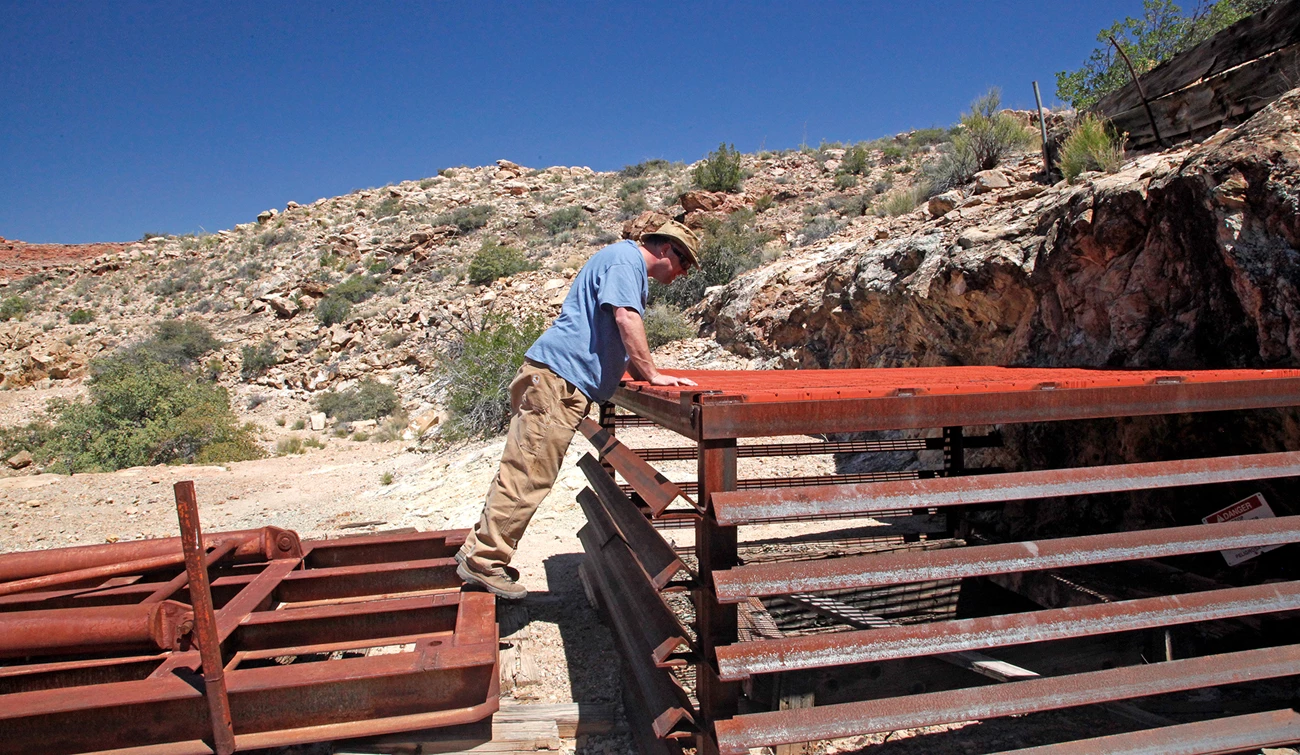
NPS - J. Axel 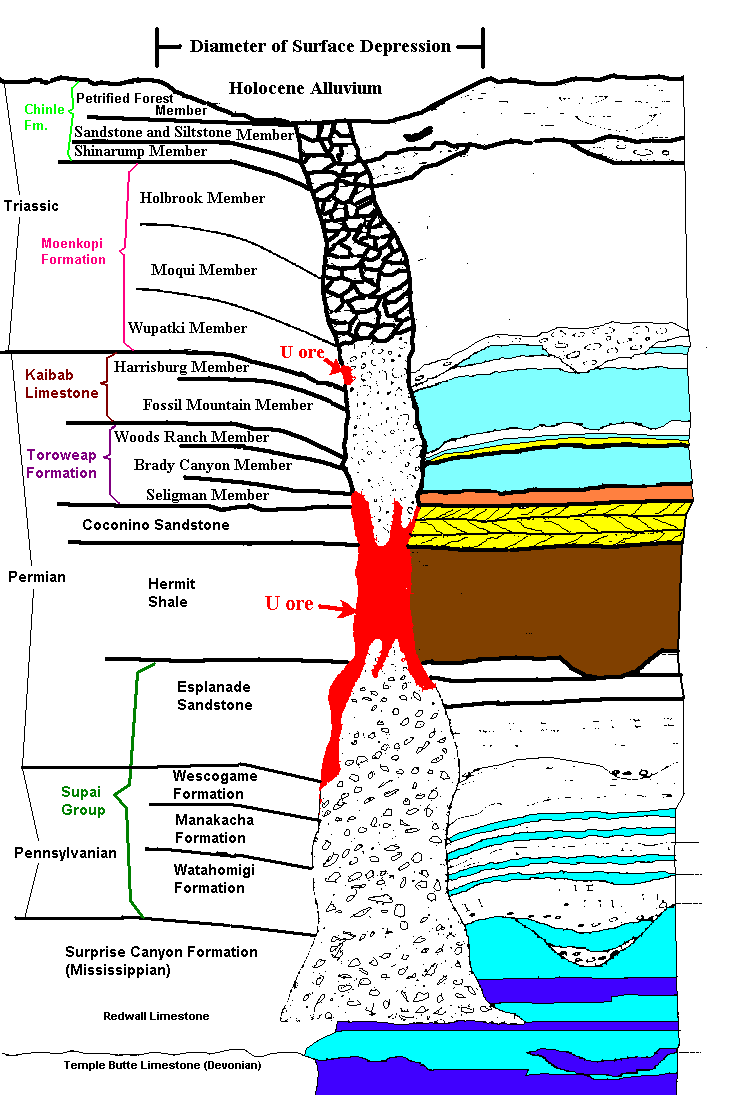
The term 'breccia' is a common feature familiar to geologists. Breccia is essentially broken rocks underground that have fallen to fill a void (basically an empty pocket with no connection to the surface). What is so unusual in and around the Grand Canyon is that these breccia features come in the form of vertical pipes that are filled with broken rock. How they formed and a few became mineralized with rich deposits of copper, silver, uranium, and a few other valuable metals is quite remarkable and an area of continued geologic research. Breccia pipes in the Grand Canyon region first attracted miners in the 1870s. Within Grand Canyon-Parashant National Monument are many such mines. Two of the most popular for the public to visit include the Grand Gulch Mine in the Grand Wash Cliffs, and the Copper Mountain Mine, in Parashant Canyon. Near the Grand Gulch Mine are the Savannic and Cunningham mines that require a UTV to visit due to the incredibly rough roads. At its height of productivity in the early part of the 20th century, the Grand Gulch Mine produced up to 75% pure copper ore, which astonished geologists and miners alike. At nearby Grand Canyon National Park, several breccia pipe mines can be seen such as the Orphan Mine near Hopi Point or the Grand View Mine on the Horseshoe mesa. Watch Parashant's new 12 minute film about the history of the Grand Gulch Mine Some may ask if breccia pipes are similar to open pit copper mines found in other areas of the southwest. A porphyry deposit is similar to a mineralized breccia pipe in that hot fluids from deep in the crust brought minerals dissolved in the water and were deposited as they cooled. In breccia pipes these were concentrated in narrow pipes up to 75% copper. In a porphyry deposit the copper is much more diffuse, perhaps 0.25% concentration, which requires open pit mines. Examples include the Morenci Mine in eastern Arizona and the Bingham Mine near Salt Lake City. 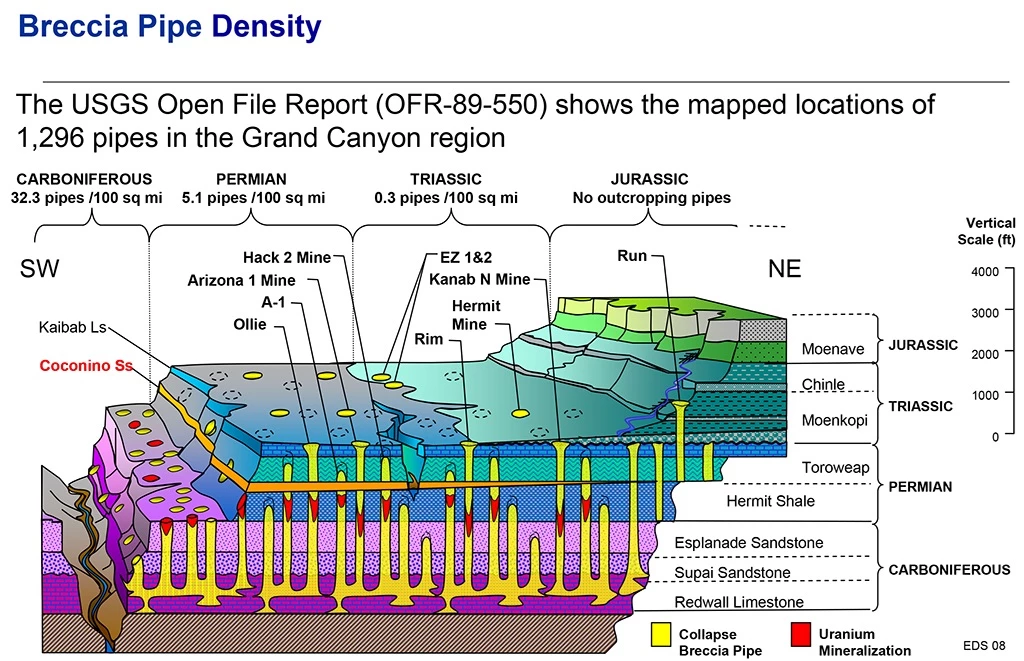
US Geological Survey 
Google Maps (click the image to go to this location in Google Maps) The region that would come to be known as the Colorado Plateau kept slowly sinking due to interactions between the North American continent and subsiding ocean floor that was close to sea level. Sometimes the region was below sea level. Sometimes it was just above it. Over time though the trend was that the crust was sinking, allowing deposition of layer after layer. These warm shallow seas were perfect for the formation of limestone layers, such as the Kaibab, as well as the most important for this story, the Redwall limestone. At other times, plate tectonics allowed the land to rise up a little bit. The land rose above sea level and mudstones like the Kayenta or Hermit were deposited in ancient river deltas like what the Mississippi River is creating today. At other times sand dunes covered the land right up to the edge of the ocean similar to the Skeleton Coast of Africa today. These sand dunes became formations like the Coconino. Over several hundred million years, because this was a lowland compared to the rest of the continent to the east, it continued to collect sediments. These sediments were delivered by rivers from the ancient Appalachian mountains far to the east. It was within this layer cake of ancient deposits that thousands of breccia pipes could develop. But how and why? 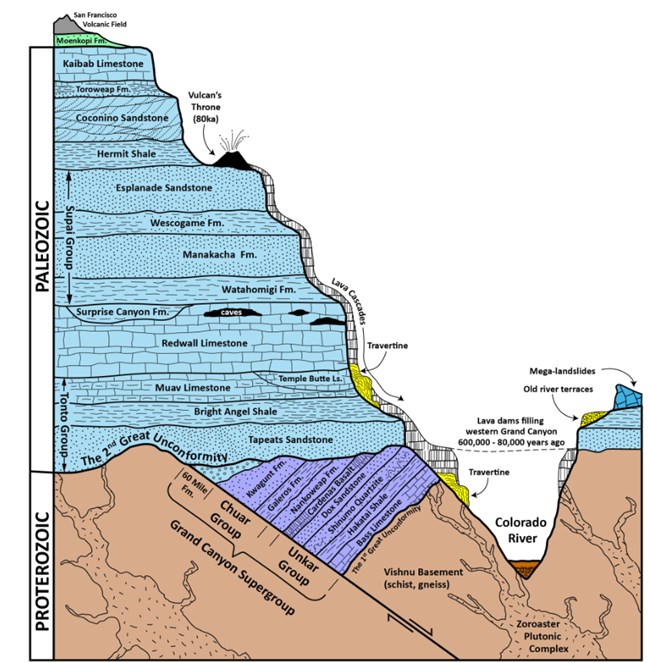
University of Arizona Caves are not stable on a geologic timescale. As anyone who has visited a cave knows, giant boulders litter the cave floor. They clearly fell off the ceiling. Over geologic time, the roof of any cave will at some point collapse. But this doesn't fill in the chamber, it just moves the floor of the cave upward since what was on the ceiling is now on the floor. This then creates a new, higher ceiling. Over tens of millions of years, collapse after collapse after collapse, the cave climbs upward, creating a vertical, rubble-filled pipe. Here in the Grand Canyon region, these collapses eventually ascended several thousand feet until each one finally pinched out in the upper Colorado Plateau layers like the Chinle formation. What remained was a vertical tube hundreds of yards across filled with collapsed rock and gravel. A sinkhole is another term that basically describes a breccia pipe. We now have our breccia pipes. The third phase of this process was mineralization. Something had to deposit the valuable copper, silver, and uranium ore in the jumble of rocks in the breccia pipe. The minerals got there because of a special liquid called hydrothermal fluid. Hydrothermal fluid is basically extremely hot water that has been heated by Earth's mantle. This water can exist at extreme temperatures since since it is trapped by rock, it can't boil or escape to the surface as steam. It is considered supercritical and can be hotter than 1,000 degrees Fahrenheit deep in the crust. Most important, it contains lots of dissolved minerals, gases, and salts. This includes everything from quartz to copper to carbon dioxide. How can be water deep underground? It gets there in part by the subduction of the ocean plates under continents. Water gets dragged down with the subducting plate. Much of it is left over from when Earth first formed. It is said that there is several times more water in the mantle than in all the oceans of the world. However, it isn't down there in great pools of fluid. It is spread out amongst the minerals. It needs something to set it free from its rocky trap. What frees it? The key here is that Earth's mantle convects. This means that hot solid mantle rock (with a texture like putty) slowly churns. It flow from near Earth's core toward the crust at the speed your fingernail grows. This is called convection. As the heat is transferred into the crust it mobilizes water that starts to flow toward the surface. As the water cools it is ready to leave metals behind when conditions are right. Often, hydrothermal fluid intrudes into the cracks of rocks, leaving behind thick veins of quartz. Miners dig the quartz out because valuable metals like gold, silver, and copper are often found mixed in with the quartz. In the copper porphyry deposits of open pit mines in the region, vast networks of microscopic cracks allow minerals to be deposited over a huge area. In the breccia pipes of the Arizona Strip, the hydrothermal fluid and its dissolved minerals were instead concentrated in the skinny breccia pipes, resulting in high metal concentrations. One mystery continues to puzzle geologists. Only about 4-8% of the known breccia pipes contain enough minerals to be mined profitably. The rest don't have hardly any metals at all in them. This is an area of active research. Are there perhaps high concentrations of copper much deeper in the crust, perhaps in the basement rocks that are Precambrian in age? 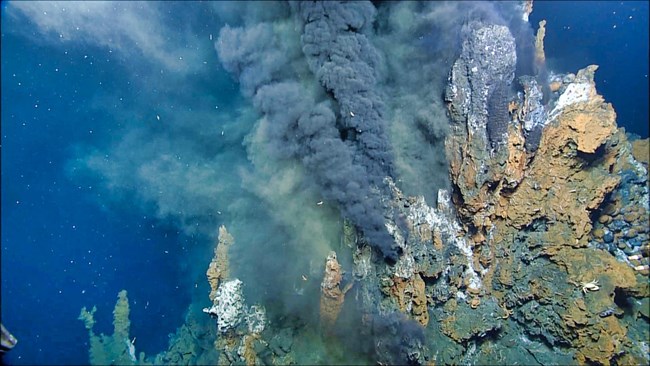
USGS In the photo at left of the hydrothermal vent, the ocean floor is about the only place to see hydrothermal fluid in action on Earth. The water gushing out of these vents can be under thousands of pounds of pressure per square inch and incredibly hot. While not the same as what happened in the breccia pipes, as conditions change for these hot fluids carrying dissolved minerals, you can see how changing temperatures and pressure can allow metals can be deposited. Curiously, while both copper and uranium can be present in breccia pipes in northern Arizona, there was a notable shift in concentrations across the landscape. From the Grand Wash Cliffs near the Nevada border east to Mt. Trumbull, the breccia pipes that do have mineral deposits of copper seem to only have trace amounts of uranium. East of Mt. Trumbull, uranium became more prominent and copper concentrations drop. This is another mystery being researched by geologists. Why is copper more common in some places and uranium in others? This brings us to the human aspect of this story. How did miners discover these breccia pipes? Erosion is needed to expose the deeply buried breccia pipes. Forces in the mantle and the crust caused the Colorado Plateau to begin to ascend. It started to erode as streams and rivers cut into the rocks and stripped away layer after layer. Erosion eventually excavated the landscape down to the top of the breccia pipes between the Kaibab limestone and Chinle formation. This exposed the tops of some of the pipes. Eventually the colorful blue and green copper ore was exposed. It lay on the surface or was washed into streambeds for miners to find. 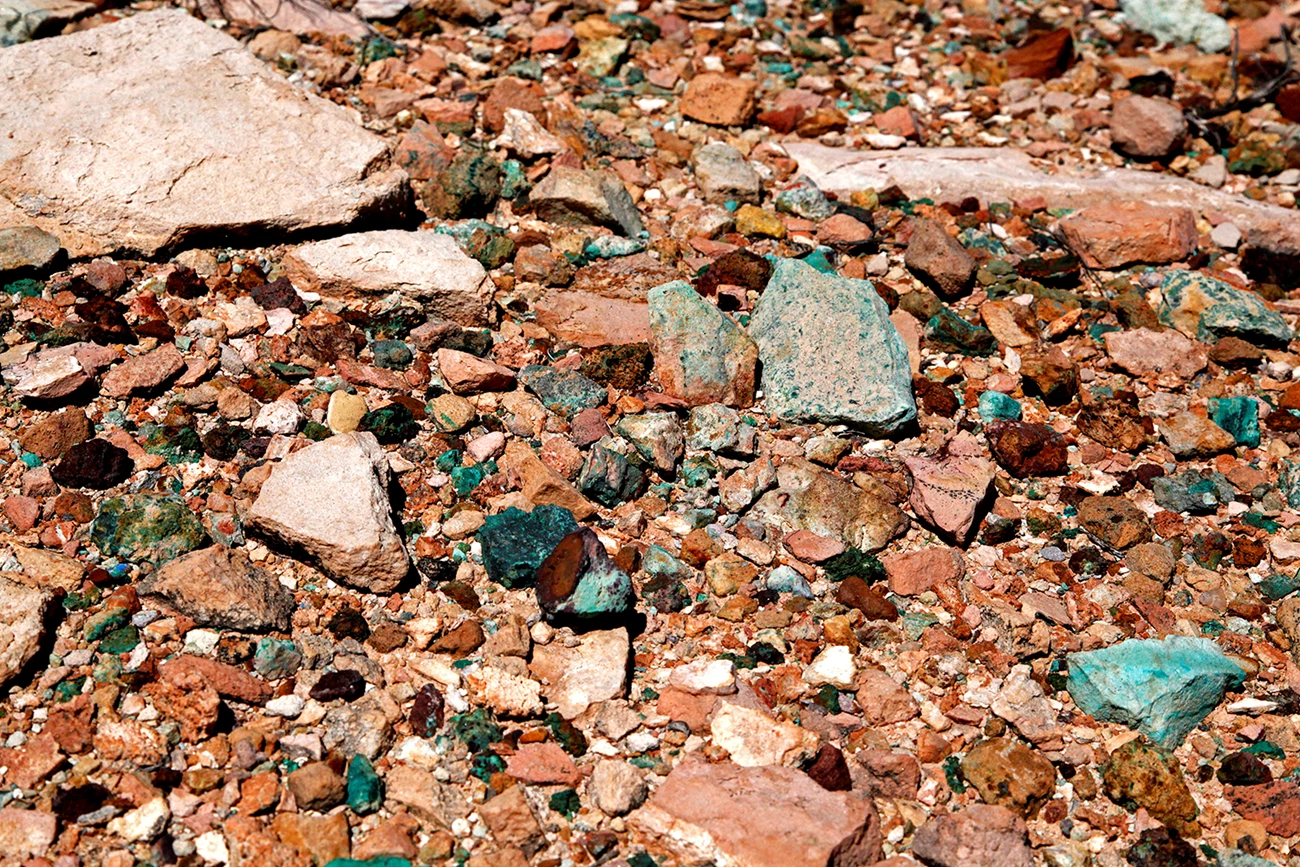
NPS - J. Axel
Once erosion had excavated away the rock layers above a pipe, the breccia pipe was finally exposed. Native Americans and new settlers to the area looked for these colorful stones. If green or blue copper ore was seen, the person would 'follow the color' upstream to the source. This location information could then be sold to a mining company. The mining company would explore the site and if the ore tested rich enough, a claim was filed and mining began. Even if a mine produces high quality ore, there are costs to consider if the venture is to be successful. One cost is whether to process the ore on site in a mill and smelter. This would significantly decrease costs as the metals would be more more concentrated. The other method was to transport the heavy ore to a mill far away for processing, which was expensive. The Arizona Strip was so remote that no large scale transportation system, like a train line or ore processing facility existed nearby. For years ore had to be shipped by wagons pulled by mule teams. Later it was transported by trucks. Miners must have certainly dreamed that one day a railroad company would put in a spur line to their mines on the Arizona Strip. 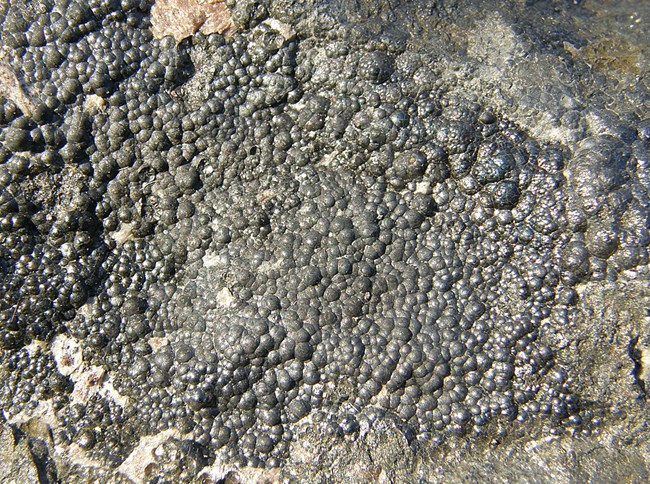
Wikipedia - Geomartin A final question is if these breccia pipes inside areas like Grand Canyon National Park or GC-Parashant National Monument will ever be mined again? The answer is no. Laws have been passed to prohibit mining in these protected places. From concerns about uranium contaminating ground water that could make its way into the Colorado River to prioritizing tourism over industrial mining in the Grand Canyon region, mining has been reduced to a fraction of what it once was. This story of mineral wealth in breccia pipes around the Grand Canyon is mostly part of the nation's history now. Still, visitors to the Grand Canyon-Parashant region can ponder those days long ago when small but rich deposits of minerals tantilized the explorer dreaming of adventure, the spectre of hard work, and the often elusive allure of cashing in on some of Earth's great wealth! |
Last updated: October 21, 2023
